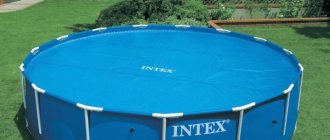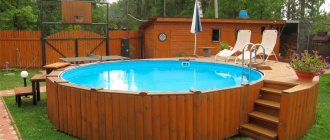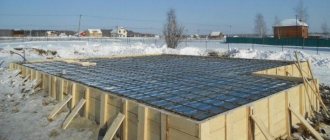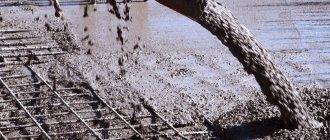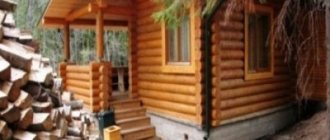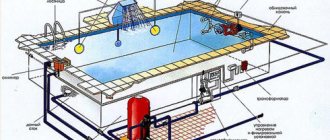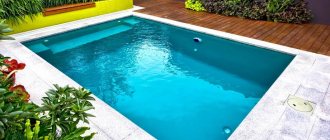After the summer, owners of frame pools are faced with the problem of how to completely disassemble the structure or carry out conservation. It all depends on the specific model. If you are going to store your pool in winter, you must carefully study all the rules and recommendations. Improper storage will lead to disastrous consequences, including the appearance of defects and damage to the elastic coating. To avoid additional losses, we recommend that you learn in detail how to store a frame pool in winter.
The story of one happy pool
This true story directly relates to the topic of the article. It happened and continues to happen successfully with our good friends.
Proper preservation and care of the pool bowl even in Siberia!
...The long-awaited and only daughter was born into an elderly family. The happy parents immediately equipped the yard with all kinds of children's swings, houses, and sandboxes. We didn’t lose sight of the pool by purchasing a frame Intex. By the time the pool was installed, the girl was 8 months old. As soon as it got warmer, little Irinka started swimming in clean homemade water! Wonderful, isn't it?
...Now the girl is 9 years old and the pool is still in service and is not going to give up. During this time, its owners only glued the bottom twice. The key to success is the proper operation and maintenance of the pool. Storing the pool bowl in winter and proper care in autumn is one of the main activities.
We deal with EVERY nuance of storing a frame pool in winter.
Is it possible to leave a swimming pool in the winter?
Dismantling the bowl of a frame pool for the winter is a troublesome and time-consuming task. The following point is also confusing: after being in use, the product loses its original strength. Owners of a summer accessory are tempted to leave everything as is. Some pools can actually be disassembled to a minimum.
Advice from Chistyuli. A frame pool does not need to be disassembled for the winter if the structure is made of all-season materials, that is, frost-resistant. The inflatable pool is washed, drained, and dried at home. You cannot leave the inflatable bowl outside.
If you live in a warm climate, where winter frosts are very rare, you can safely leave the pool without disassembling it. However, in the northern regions, even swimming pools installed in unheated buildings need conservation. Severe frosts reach the remaining water in the equipment and the containers burst.
What are the features of storing a frame pool “recessed” into the ground in winter? There is ambiguous opinion regarding pools buried in the ground. Owners of such structures claim that pools survive the winter without problems, while the water remains in the bowl. Experts explain that when the soil freezes, it puts pressure on the walls of the pool. In turn, the water remaining in the bowl also freezes and puts pressure on the walls. Over time, serious deformation of the structure occurs.
Why does the pool need to be dismantled?
Despite the manufacturer’s promise that the bowl will feel good even in cold weather, it is worth the effort and dismantling of any product, including all-season products. Some environmental factors can cause spoilage. These include:
- Extreme drop in temperature.
- Large temperature changes.
- Heavy snowfalls, hail.
- Hurricane winds and thunderstorms can demolish the pool or deform the walls and bottom.
- Precipitation will constantly moisten the pool, certainly falling into the bowl.
Agree, the vagaries of nature are beyond human control. It remains to figure out how to store a frame pool during the cold season. I continue the list of possible problems.
- Over a long winter, the soil may swell. To counteract heaving, it is recommended to leave plenty of water, which will stop the process under the influence of its own weight.
- There is a good chance that the lower nozzles will freeze into the ice and will simply be torn out of the bowl when the ice thaws in the spring and water accumulates at the bottom of the pool. In addition, water also remains inside the nozzles, which can easily tear the structure.
- Temperature fluctuations will cause the water to either freeze or thaw, which is also harmful for the pool and its plastic.
- Attempts by representatives of the local fauna are especially important for a swimming pool left unattended at a dacha.
- Hooligan antics of uninvited visitors to the summer cottage.
- Theft of property left unattended for a long time.
General sequence of actions
The peculiarity of frame models is that they all make it possible to disassemble the structure and preserve it for the winter. At the first stage, it is necessary to clean the surface of the pool from dirt. Most often they are calcareous and silty deposits. It is recommended to carry out this procedure consistently, gradually draining the water from the container. The procedure is as follows:
- cleaning the pool walls;
- draining water from the container;
- drying the structure;
- dismantling of structural elements.
To dry, you need to choose an open sunny space in which the product will be ventilated. Small objects of light weight can be placed on pre-hung ropes. After the main moisture has evaporated, hard-to-reach places and folds should be treated with rags for better water absorption. In poorly wiped areas, fungus or mold will most likely appear in the future, which will negatively affect the safety of the pool.
How to dismantle a pool
Here's how to properly store a frame pool in winter so as not to damage the soft font. When preparing a pool for conservation, the following recommendations from manufacturers will be useful:
- Start preparing immediately at the end of the swimming season. Don't expect heavy rains or frost. It will take several days to prepare for storage.
- The right chemical will help clean the bowl and parts of the pool without causing damage. When choosing chemistry, keep in mind that you will have to deal with plastic and metal.
- Take care of auxiliary accessories: rags, soft brushes, sponges.
- Make sure in advance that you have enough space to drain a large volume of water.
Let me remind you that only water free of reagents can be poured into the soil. If you add detergent, disinfectant, or bleach to the pool, the chemicals will simply scorch the ground. Next year there will be a bald patch without plants.
Video. Winter maintenance of the pool
Preservation of frost-resistant structures
Some swimming pools of popular brands cannot be disassembled - this option is not possible due to design features. The most popular frost-resistant models are produced by the GRE and Bestway brands.
All-season products have several layers: vinyl (protecting the water from rapid cooling) and metal (preventing damage to the bowl). How to store a non-demountable frame pool in order to get a complete product ready for use in the spring?
- Carry out all work in dry, warm weather.
- Remove the disinfectant dispenser from the built-in autochlorinator.
- Turn on the system's automatic flushing for 20-30 minutes. This feature is not available for every pool. Add a preservative to the code so that the pump circulates it throughout the system. Remember that you cannot pour water with preservatives into the soil or reservoirs. Use the sewer, save nature.
- Drain the water thoroughly. Pay attention to all elements that will not be dismantled - they also need to be COMPLETELY freed from water.
- Drain the water, simultaneously cleaning all the elements from plaque. Use chemicals approved by the manufacturer. Use a soft brush or rag. Pay attention to ground structures and dismantled elements: stairs, railings, backlights, etc. You should not leave water used for bathing for conservation.
Advice from Chistyuli . There are horror stories on forums about how a swimming pool has to be filled with purchased water, since the local water looks like a cultivated swamp. The owners of such pools are unlikely to drain the “golden” water. In this case, preserve the structure as if it were frost-resistant.
Let's continue...
- Remove all possible components: protective glass, lights, etc.
- Take care of the wiring insulation. In the places where dismantled electrical products are installed, place dense dielectric plugs (they can be easily made from foam plastic).
- Dry the non-removable parts and wrap hermetically in cling film. Also make sure that all openings are closed.
- Fill the pool, cleaned of dirt and chemicals, 2/3 full with clean water with the addition of special products for winter storage: “Puripul Bayrol”, “Winterpool”, etc., diluted in a ratio of 1:5. This will protect the water from the development of bacteria. Or perform shock chlorination. You cannot leave a pool without water over the winter.
Shock chlorination of a pool is performed using special means. AquaDoctor C-60 and C-60T are popular. Dosage 20 grams / 1 cubic meter of water. Shock chlorination is repeated in the spring before the start of operation and repeated every 45-60 days in the summer.
- Install compensators: several five-liter bottles at the rate of 1 bottle per square meter of area. Using counterweights, drown the bottles to ¾ of their volume. As a counterweight, use sand or small pebbles, filled halfway into each bottle. When water freezes, the bottles will become deformed, but the bowl will remain unchanged. Compensators protect the thicket from fractures and deformation. When installing, distribute them evenly over the entire area of the pool. It is convenient to place bottles diagonally in one row or crosswise. The distance between compensators is 10-15 cm.
- How to store a frame pool in winter? Adjust the water level so that it is 15-20 cm below the return nozzles. After lowering the compensators into the water, the water level will rise. Adjust it again.
- I recommend using a special covering awning - a winter “blanket”, which can be purchased complete with the pool. Pour more water onto the awning - it will press the blanket to the edges of the pool, which will create additional sealing and at least partially protect from the wind.
Winter preservation rules
If you have an all-season model in mind, then in order to avoid damage to the equipment and perform quality conservation, you must adhere to the following recommendations:
the tank must be preserved until the air temperature drops to 0°;- The pool bowl must be filled with water;
- Water should be added only after cleaning work has been carried out inside the pool and the equipment has been removed;
- When cleaning tank walls with special compounds, precautions should be taken because they are toxic;
- Removal of equipment inside the tank must be done carefully so that the hydraulic system is not damaged.
It is prohibited to add preservatives to water intended for swimming!
Seasonal models begin to be dismantled, after draining the water. The procedure is not particularly difficult, but compliance with some rules is mandatory:
- Simultaneously with draining the water, it is necessary to thoroughly clean the entire internal surface. First of all, completely remove limescale from the metal parts of the structure.
- To prevent small structural parts from getting lost, it is better to pack each of them separately.
- You need to dry the pool as best as possible.
- If heating is not provided in the room where the dismantled structure will be stored, dense packing of the material is required, because Due to its fragility, it can be damaged by exposure to low temperatures.
Where to store the pool
How to properly store a non-frost-resistant frame pool in winter? Plastic parts of such structures are afraid of frost, so a room with above-zero temperatures is suitable, but not hot. A rolled up pool takes up a lot of space, so in a pinch, utility rooms are suitable:
- attic
- canopy
- barn
- garage
- basement
- summer cuisine
- greenhouse
- workshop
- cellar
- pantry, balcony, loggia
The optimal temperature for storing a frame pool is from 0 to 40℃, ideal 18℃. To avoid mold, the room must be dry and with a minimum humidity threshold. Deny access to any animals, both domestic and wild.
Work order
To preserve the product, it is first recommended to perform the following measures:
- drain the water;
- dry the tray;
- collect shelter.
As soon as it’s time for cold weather, and in Russia in some regions the warm period is short-lived, immediately begin the actions described above, otherwise there is a chance of being late: due to a sharp drop in temperature, the water in the pool will freeze. In terms of time, all actions will take two days; in fact, you will be involved in the process for only 2 hours, the rest of the period is devoted to draining the liquid and drying the product.
On the first day, the container is cleaned, the bowl is emptied of water, on the second day the structure is dried and dismantled. The disassembly itself also does not take much time, the main thing is that the device is dry, during storage it is necessary to exclude the possibility of mold formation.
